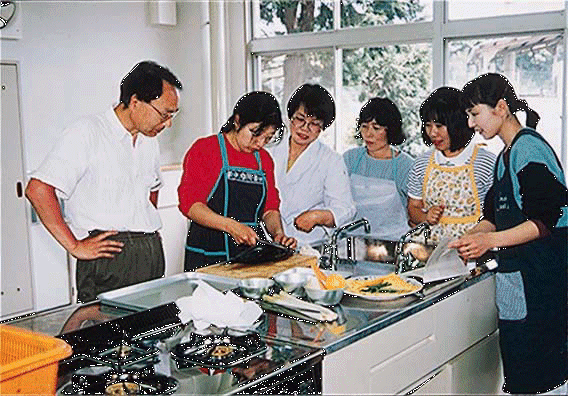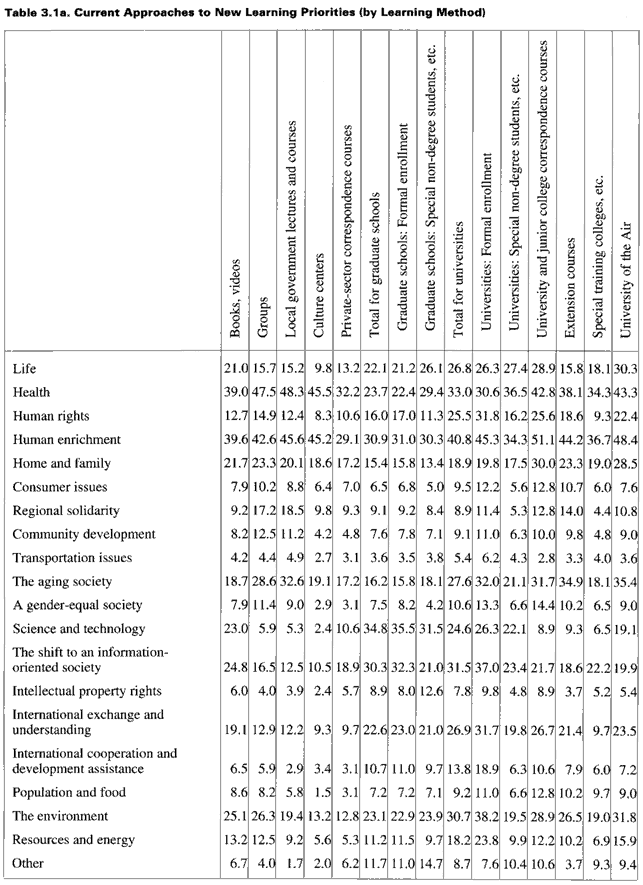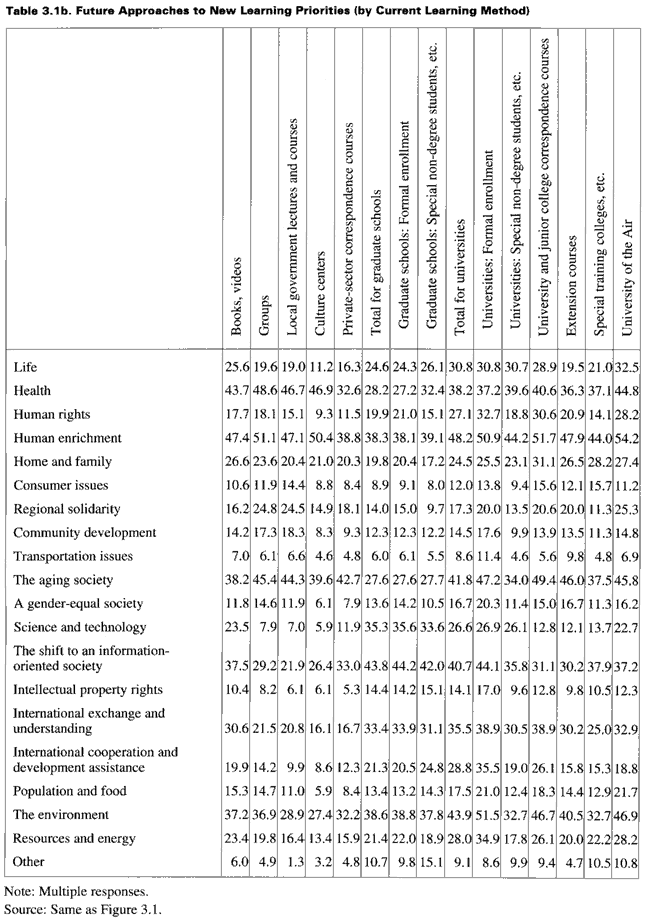| Home > Policy > White Paper, Notice, Announcement > White Paper > JAPANESE GOVERNMENT POLICIES IN EDUCATION, SCIENCE, SPORTS AND CULTURE 1996 > Priorities and Prospects for a Lifelong Learning Society Chapter 3 Section 1 1 | ||
It is necessary to provide diverse and comprehensive learning opportunities to meet today's learning needs. Providers of learning include schools, social education facilities, sports and cultural facilities, and various other institutions and organizations.
Approaches to the provision of learning activities must be broad enough to encompass this diversity. In addition to the development of comprehensive plans, it is necessary to build systems that allow wide-ranging cooperation, including links among various government departments and agencies.
On April 24, 1996, the Lifelong Learning Council presented recommendations concerning agencies providing individual learning opportunities in a report titled "Measures to Improve Lifelong Learning Opportunities in the Community." The main measures in this area are likely to be as follows.
The public's growing demand for lifelong learning has created a need for advanced structured, specialized learning opportunities. Institutions of higher education, including the University of the Air, have an important role to play in meeting this need.
The University of the Air can make an especially important contribution as an institution of higher education that is accessible to all, with no limits on time and location.
The University of the Air was created to bring higher education to the wider public through radio and television broadcasting and is regarded as a core component of lifelong learning systems. In line with its goals, the University of the Air does not select entrants by means of examinations. Its students are divided, according to their learning format, into
The University of the Air was established in 1983 and began to accept students in April 1985. Its diverse student population consists of approximately 62,000 people who vary widely in age, occupation, and other attributes. To date it has produced over 8,000 graduates. At present the broadcast range of the University of the Air is limited to the Kanto region of eastern Japan, which is covered by transmissions from Tokyo Tower and a transmission facility in Gunma Prefecture. Preparations are being made for the introduction of satellite broadcasting, which will extend coverage nationwide. Nationwide coverage will also require the establishment of local learning centers for such activities as face-to-face instruction (schooling) and credit certification examinations.
Regional study centers * are being established to provide University of the Air programs based on video and audio tapes used in broadcast lectures. The goal is to create centers in the 40 prefectures not already covered by University of the Air broadcasts. So far centers have been established in 31 prefectures.
* Regional study centers: Regional study centers are being established as part of preparation for the use of satellite broadcasting to provide nationwide coverage by the University of the Air, whose range is currently limited to the Kanto region. In fiscal 1996 there were 31 such centers. Until nationwide broadcasting begins, these centers will use videos and other materials recorded from broadcast lectures to bring university education to the general population in order to meet the need for lifelong learning.
Universities, junior colleges, and other institutions of higher education are working to improve adult access by introducing special selection systems for adults, evening graduate schools, special register systems, programs for special non-degree students, and systems for transfer admission to universities. There has been a steady increase in the number of people studying under these systems.
The number of universities accepting special register students at the undergraduate level rose from 116 in 1992 to 358 in 1994. There was also a dramatic increase in the number of students accepted on this basis, from 2,119 in 1992 to 10,056 in 1994. It is hoped that use of these systems will continue to expand. (See chapter 2, section 1, subsection 7. )
Another priority is the expansion of extension courses. It is especially important to establish courses with content and levels that utilize the special characteristics of institutions of higher education. There is also a need for efforts targeted not only toward adults but also toward young people, such as the establishment of courses that provide young people with a simplified introduction to the latest research and the creation of "hands-on enrollment" systems in schools. In addition, universities and other institutions should take the initiative in distributing information on their activities in this area, ideally in cooperation with local governments.
Improvement of educational institutions' organizational systems is a priority for ensuring the effectiveness and continuity of these efforts. In recent years some institutions have established organizations to serve as hubs for lifelong learning at all levels. By fiscal 1995, 12 national universities and 1 national junior college had created organizations of this type under such names as Lifelong Learning and Education Research Center. In fiscal 1996 similar organizations were established at Hirosaki University and Toyama University.
Local public and private universities are also moving in this direction. As of fiscal 1995, 6 local public and 64 private universities had created organizations with various names and functions as part of efforts to improve access. Many other universities are expected to make similar improvements to their systems in the future. Institutions of higher education should also improve access to such facilities as libraries, gymnasiums, and athletic grounds. In addition, they should respond to learning needs through such means as the establishment of university museums and the organization of exhibitions and lectures.
Professional training colleges respond to the needs of society by providing occupational education and specialized technical education. In addition to their significant quantitative contribution to higher education, they play an important role in the diversification of higher education.
In 1994 day/evening courses and the special register system were introduced. In 1996 day/evening courses were available at 56 professional training colleges, while 63 accepted a total of 1,843 special register students. Another innovation introduced in 1994 was a system to allow professional training colleges to accept subjects studied at other professional training colleges, at universities, and at other institutions as optional subjects.
Professional training colleges need to take advantage of the freedom and flexibility provided by these systems to respond appropriately to the needs of an increasingly sophisticated and complex society. They are also expected to play an active role in the lifelong learning society.
Elementary and secondary schools are increasingly seen as providers of learning opportunities for local communities. At the upper secondary school level, in particular, there is strong demand for community access to extension courses and school facilities. A significant percentage of facilities are already open to the community in some form, but conditions of access, including days and times when facilities can be used, vary considerably, and community learning needs are not always met satisfactorily. Further improvements in access are needed.
One factor hindering the improvement of access is concern that schools may be held liable if accidents occur while their facilities are open to the public. It is therefore necessary to clarify facility management responsibilities as part of efforts to create improved access systems. It is also necessary to ensure the appropriate deployment of management and guidance personnel and to establish committees with the cooperation of the community. Another issue that will become more important in the future is the effective utilization of classrooms that are no longer needed owing to the declining number of schoolchildren. To facilitate public access to school facilities, it is also necessary to design schools from the start with a view to eventual public use.
The opening of school facilities to the public is an extremely effective way of providing convenient venues for learning activities in communities. This trend should therefore be encouraged.

Facilities for social education, sports, and culture play an integral role in the community and have traditionally been linked closely to community learning activities. While such facilities are already contributing to some extent, revitalization is needed to enable them to accommodate the growing diversity of community learning activities.
Efforts to provide learning opportunities must reflect residents' learning needs, which range from work-related knowledge and skills to civic awareness, social cooperation, and life skills, such as nursing. The priorities in this area thus include comprehensive planning and coordination among facilities.
Culture centers and other private-sector education enterprises are also actively involved in this field. Their facilities provide a wide spectrum of learning opportunities in response to the diverse learning needs of communities and play an important role in a wide range of community learning activities.
In September 1995 MESSC issued a notice clarifying the interpretation of the Social Education Law to specify that it was acceptable for private-sector profit-making education enterprises to use citizens' public halls. Their availability for use by private-sector education enterprises will enhance the availability of learning opportunities. Further studies from this perspective are needed.
The improvement of personnel systems, including the training and pooling of specialized staff and the acceptance of volunteers, is a priority in the management of citizens' public halls. The days and times that they are open should be as flexible as possible and should accord with community needs. In addition, the special learning needs of various groups, such as children, the aged, the disabled, and foreigners, should be taken into account in the development and management of citizens' public halls.
Some facilities of government ministries and agencies, local governments, and business corporations have learning resources with the potential to contribute to learning activities in the wider community, even though the facilities may not have been originally designed for this purpose. There are already a number of such programs. For example, research institutes affiliated with the Science and Technology Agency run Science Camps for upper secondary school and college of technology students, while the Forestry and Forest Products Research Institute of the Ministry of Agriculture, Forestry, and Fisheries offers family-oriented forest courses and classes. Further efforts should be made in this area.
As already mentioned, the key emphasis of the concept of lifelong learning should be voluntary activities reflecting the wishes of learners themselves. Government agencies working to improve learning opportunities should bear in mind the need to encourage voluntary learning activities by supporting independent group and individual learning.
Learning activities have generally been provided free or for fees amounting to little more than the cost of teaching materials, especially when the public sector is involved. The cost of learning activities is expected to rise, however, as learning needs become more sophisticated and diverse. Under these circumstances, maintenance of traditional approaches to cost sharing could actually have the effect of limiting the improvement and expansion of learning opportunities. Consideration should be given to the introduction of cost-sharing methods that are appropriate to the aims and content of learning activities and the attributes of learners. This aspect should be recognized as an issue that affects all public-sector learning institutions. It needs to be considered from the perspective of the organizations involved, such as national or local public universities offering extension courses or local governments establishing and administering courses and classes.


| Back to Top | MEXT HOME |